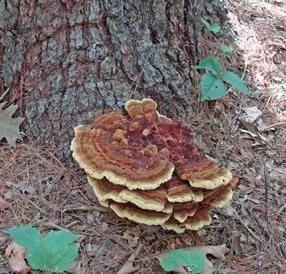Velvet-Top Fungus/Cowpie Fungus/Dyer's Polypore (Phaeolus schweinitzii)
Trees Affected
Common: Most conifers, notably Douglas-fir and Sitka spruce along the coast
Summary

Local Distribution
Widespread across region.
Management Strategies
Avoiding root injury can somewhat reduce the likelihood of infection with Phaeolus schweinitzii. However, given how common this fungus is across the northern hemisphere and given that it serves an important ecological function, total avoidance is both unlikely and undesirable. However, the structural damage caused by Phaeolus schweinitzii can be estimated by coring the tree and assessing how much brown rot is present within the bole. If the affected tree is in an area with significant human traffic, removal may be necessary for public safety. If the affected tree is in an area where it is unlikely to damage property or people, management strategies include shorter harvest rotations for timber, or taking no action and recognizing that this fungus has an overall positive impact on forest health.
Pests and Pathogens with Similar Symptoms
Fomitopsis pinicola: This fungus also produces a cubical brown rot, but enters through aboveground wounds. Fomitopsis pinicola fruiting bodies are perennial conks with a smooth white underside and a reddish-brown top.
Laricifomes officinalis: This fungus produces a cubical brown rot, but enters through branch stubs much higher up on the tree. The fruiting bodies of Laricifomes officinalis are perennial light-colored hoof-shaped conks, often located at the base of branch stubs high up on the trunks of old-growth conifers.
Further Reading
Disease description, management, and additional resources:
